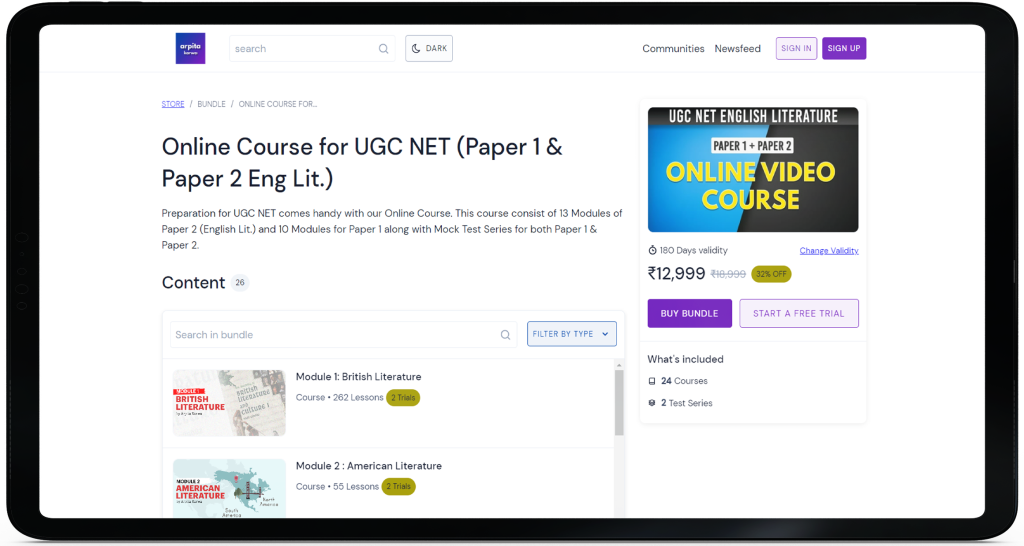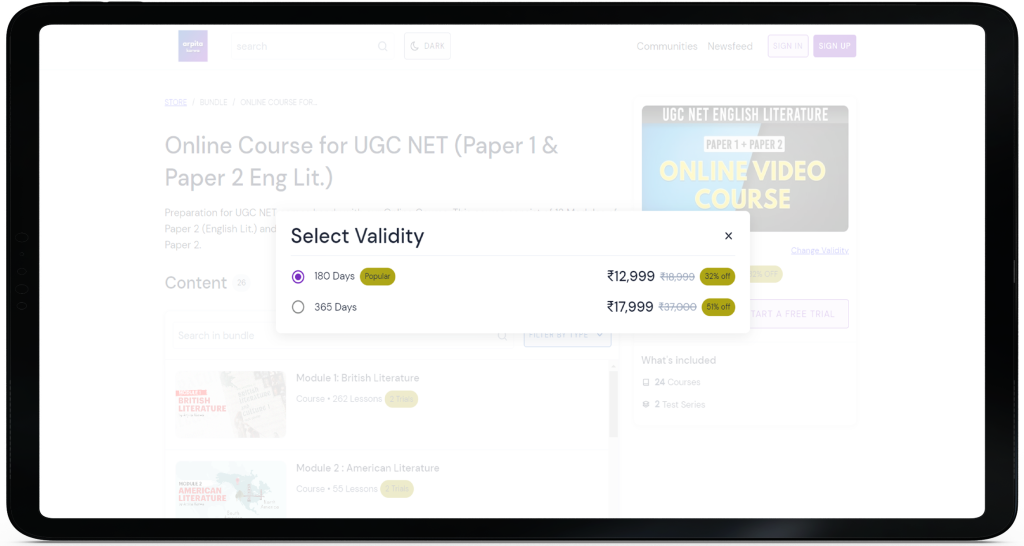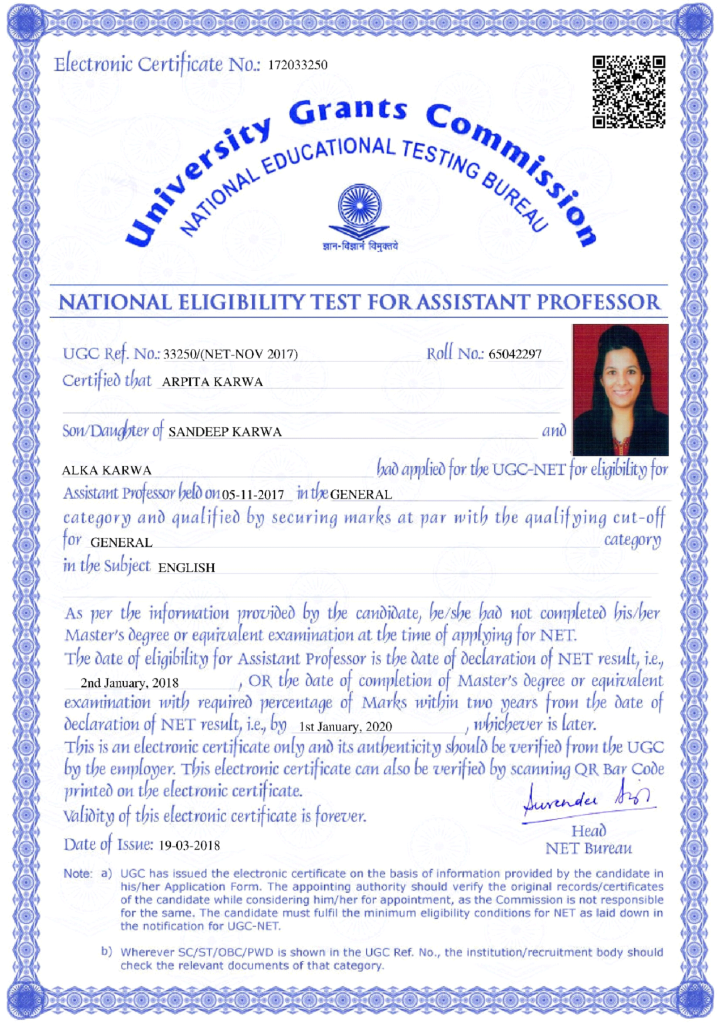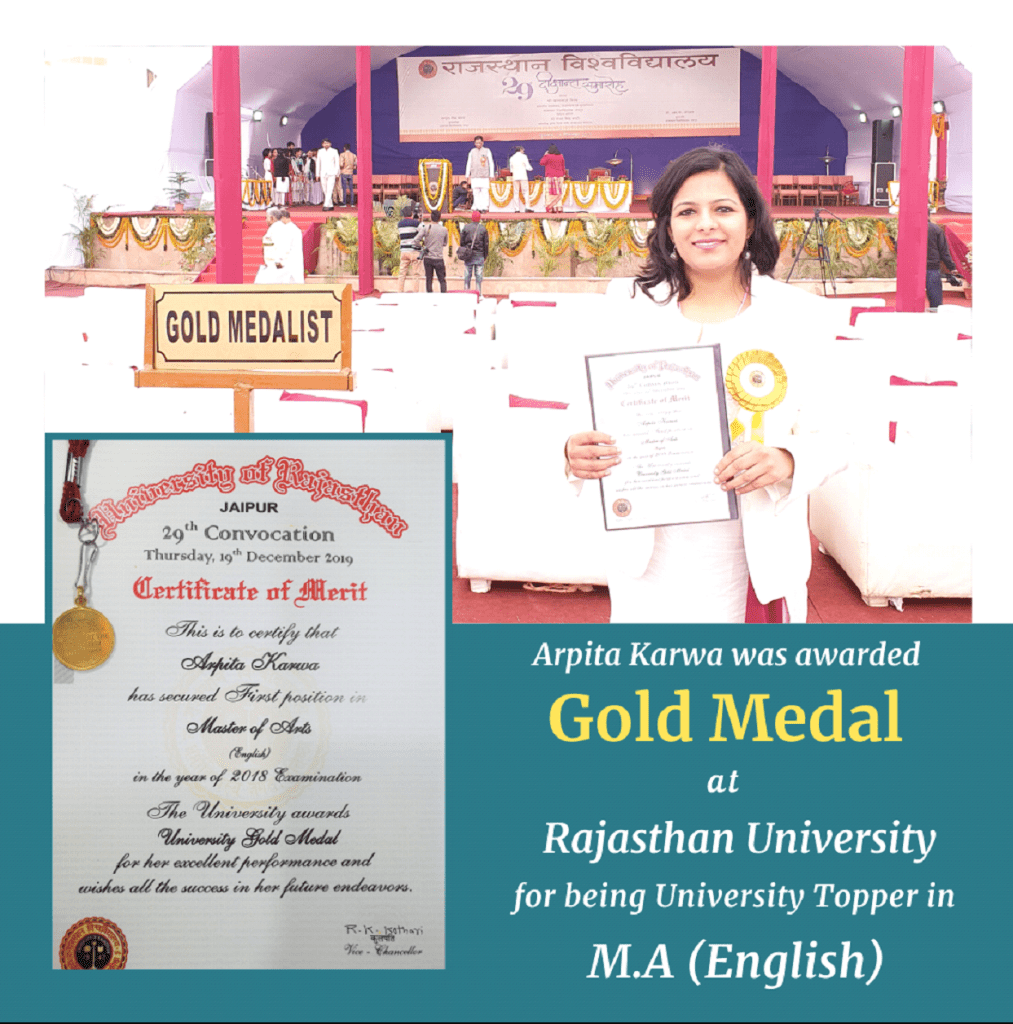June 2024: Paper 2 (Conducted on 18th June 2024 : Shift 2)
June 19, 2024 2025-10-13 14:48June 2024: Paper 2 (Conducted on 18th June 2024 : Shift 2)
June 2024 : Paper 2 (Conducted on 18th June 2024 : Evening Shift)
Q.1) Which among the following is not a type of meaning in a poem as defined by I.A. Richards Practical Criticism?
[1] Feeling
[2] Form
[3] Tone
[4] Intention
Answer – [2]
Q.2) What is the correct sequence of various periods of English Literature?
A. Caroline Age
B. Jacobean Age
C. Restoration Age
D. Commonwealth Period
E. Augustan Age
[1] D,B,A,E,C
[2] A,E,B,C,D
[3] B,A,D,C,E
[4] E,C,A,D,B
Answer – [3]
Q.3) Which of the following works is not written by Chinua Achebe?
[1] Arrow of God
[2] No Longer at Ease
[3] An Image of Africa
[4] Weep not, Child
Answer – [4]
Q.4) Name the British poet who wrote Sohrab and Rustum :
[1] Mary Shelley
[2] Edward Fitzgerald
[3] Matthew Arnold
[4] Alfred Tennyson
Answer – [3]
Q.5)
A. William Congreve
B. John Dryden
C. William Wycherley
D. George Barnard Shaw
E. John Millington Synge
[1] B,C,A,D,E
[2] A,C,B,E,D
[3] C,B,A,D,E
[4] E,B,C,A,D
Answer – *
Q.6) From the following writers, who are known for Magic Realism?
A. R.K. Narayan
B. Salman Rushdie
C. V.S. Naipaul
D. Gabriel Garcia Marquez
E. Mulk Raj Anand
[1] A and B only
[2] B and C only
[3] B and D only
[4] D and E only
Answer – [3]
Q.7) Who among the following African writers observed that “O my body, make of me always a man who questions”?
[1] Chinua Achebe
[2] Frantz Fanon
[3] Ngugi wa Thiong’o
[4] Toni Morrison
Answer – [2]
Q.8) Which among the following writers once remarked that “I awoke one morning and found myself famous” ?
[1] Charles Lamb
[2] P.B.Shelley
[3] Lord Byron
[4] John Keats
Answer – [3]
Q.9) What is the correct chronological order of the works of John Milton?
A. Paradise Lost
B. Paradise Regained
C. Lycidas
D. Comus
E. L’Allegro
[1] EDCAB
[2] CDBAE
[3] ABECD
[4] CEABD
Answer – [1]
Q.10) Match List – I with List – II
List – I (Poem )
A. To His Coy Mistress
B. The Scholar Gypsy
C. Still I Rise
D. If
List – II (Poet)
I. Rudyard Kipling
II. Andrew Marvel
III. Matthew Arnold
IV. Maya Angelou
[1] A-II,B-III,C-IV,D-I
[2] A-I, B-II,C-IV, D-III
[3] A-III, B-II, C-IV, D-I
[4] A-IV, B-III, C-I, D-II
Answer – [1]
Q.11) Which of the following texts deals with the theme of creolisation?
[1] My Son’s Story
[2] Follow the Rabbit Proof Fence
[3] Things Fall Apart
[4] Wide Sargasso Sea
Answer – [4]
Q.12)
List – I (Term )
A. Anaphoric word
B. Morpheme
C. Antecedent
D. Periphrasis
List – II (Definition)
I. A unit of language that can not be analysed into smaller units.
II. Refers back to a word or phrase previously used in a text/ conversation.
III. Use of two or more words’to express a meaning which could otherwise be expressed in a single word.
IV. A word or phrase that is referred back to by a pronoun or other proform.
[1] A-I, B-III, C-II, D-IV
[2] A- IV, B-II, C-IIl, D-I
[3] A-II, B-I, C- IV, D-III
[4] A-III, B-IV, C-I, D-I
Answer – [3]
Q.13) The poetic line “Tis better to have loved and lost than never to have loved at all” appears in
[1] S.T. Coleridge’s “The Rime’of ‘Ancient Matier”
[2] Alfred Tennyson’s “In Memorium A.H.H”
[3] Shakespeare’s “Let Me Not to the Marriage of True Minds”
[4] Matthew Arnold’s “Dover Beach”
Answer – [2]
Q.14) In the 1985 essay, “Three Women’s Texts and a critique of Imperialism”, Gayatri Spivak shows development of the white liberal feminist subject. Which are the texts referred in the title of essay?
A. The Wide Sargasso Sea by Jean
B. Jane Eyre by Charlotte Bronte
C. Frankenstein by Mary Shelley
D. Pride and Prejudice by Jane Austen
E. The Mill on the Floss by George Eliot
[1] A,B and D only
[2] C,D and A only
[3] A,B and C only
[4] E,B and D only
Answer – [3]
Q.15) Barbara Smith, in her essay, ”Toward a Black Feminist Criticism”, raises concerns for:
A. Only Black women
B. Black lesbian women
C. Black women in the White world only
D. Black lesbian women amongst black women vis-a-vis the White women
E. Black and White women, both together, as they have universal concerns
[1] B and D only
[2] C and D only
[3] B and E only
[4] A and C only
Answer – [1]
Q.16) Who among the following was not associated with Cambridge School of Critics?
[1] F.R. Leavis
[2] Q.D. Leavis
[3] William Empson
[4] Kenneth Burke
Answer – [4]
Q.17) Arrange the following literary movements in chronological order of their emergence :
A. Imagism
B. Impressionism
C. Absurdism
D. Futurism
E. Pre-Raphaelitism
[1] A,C,D,E,B
[2] B,D,C,E,A
[3] D,A,B,C,E
[4] E,B,D,A,C
Answer – [4]
Q.18) Who among the following was not a proponent of Oxford Movement ?
[1] John Henry Newman
[2] Richard Hurrell Froude
[3] Edward Bouverie Pusey
[4] Charles Kingsley
Answer – [4]
Q.19)
List – I (Work)
A. Language as Paradox
B. Against Interpretation
C. Realism and the Contemporary Novel
D. Politics and the English Language
List – II (Writer)
I. Raymond Williams
II. Cleanth Brooks
III. George Orwell
IV. Susan Sontag
[1] A-I, B-II, C-III, D-IV
[2] A-I, B-III,C-II, D-IV
[3] A-II, B-IV, C-I, D-III
[4] A-IV, B-I, C-II, D-III
Answer – [3]
Q.20) What is the correct chronological sequence of the following books of D.H. Lawrence?
A. Lady Chatterley’s Lover
B. Sons and Lovers
C. The Rainbow
D. The White Peacock
E. The Plumed Serpent
[1] A,B,D,C,E
[2] D,B,C,E,A
[3] B,D,EC,A
[4] E A,B,C,D
Answer – [2]
Q.21) Who among the following was not associated with the Yale School?
[1] Harold Bloom
[2] Terry Eagleton
[3] Paul de Man
[4] Jacques Derrida
Answer – [2]
Q.22) Which is the latest edition of Chicago Manual of Style?
[1] 18th edition
[2] 16th edition
[3] 17th edition
[4] 15th edition
Answer – [3]
Q.23)
List – I (Dramatist)
A. Martin Esslin
B. Bertolt Brecht
C. Antonin Artaud
D. August Strindberg
List- II (Theatrical form/Technique)
I. The Theatre of Cruelty
II. Dream Play
III. Estrangement – effect
IV. The Theatre of the Absurd
[1] A-I, B-I, C-III, D-IV
[2] A-IV, B-III, C-II, D-I
[3] A-IV, B-lII, C-I, D-II
[4] A-I, B-IV, C-III, D-II
Answer – [3]
Q.24) Who among the following was not associated with Cockney School of Poetry?
[1] John Keats
[2] P.B.Shelley
[3] Leigh Hunt
[4] William Blake
Answer – [4]
Q.25) Patrick White, the Australian novelist, was a recipient of which of the following prizes :
A. Australian of the Year (1973)
B. Pulitzer Prize (1965)
C. Booker Prize (1955)
D. Nobel Prize in Literature (1973)
E. Perkins Prize in Narrative (1992)
[1] A and B only
[2] A and D only
[3] A and E only
[4] B and C only
Answer – [2]
Q.26) Which of the following popular Indian words have been incorporated in Oxford Dictionary in the recent past?
A. Chai
B. Bhaijaan
C. Jugaad
D. Kamaal
E. Namaste
[1] A, B, D only
[2] A,C, E only
[3] B, C, D only
[4] C, D, E only
Answer – [2]
Q.27) Choose the correct chronological sequence in which of the following works were published :
A. Vicar of Wakefield
B. Life of Johnson
C. Johnson’s Dictionary
D. Lives of the Poets
E. The Life of Nelson
[1] A,E,B,C,D
[2] C,A,D,B,E
[3] B,A,E,C,D
[4] C,B,A,E,D
Answer – [2]
Q.28) What is the correct sequence of the following novels of Amitav Ghosh in order of their year of publication?
A. The Hungry Tides
B. The Shadow lines
C. The Sea of Poppies
D. The Calcutta Chromosome
E. The Circle of Reason
[1] B,E,D,C,A
[2] E,B,D,A,C
[3] A,E,D,B,C
[4] D,C,A,B,E
Answer – [2]
Q.29) Choose the correct statements with regard to the binary pair Langue and Parole introduced by Ferdinand de Saussure
A. Langue is translated as speech and parole as language
B. Langue is the internal structure of a language not language itself.
C. Parole is the event of language.
D. Parole and language are a set of vocabulary only
E. There is no distinction between Parole and Langue
[1] A and C only
[2] A and E only
[3] C and B only
[4] A and D only
Answer – [3]
Q.30) Which of the following writers remarked that “You are your best thing” ?
[1] Toni Morrison in Beloved
[2] George Eliot in The Mill on the Floss
[3] Arundhati Roy in The God of small things
[4] Emile Bronte in Wuthering Heights
Answer – [1]
Q.31) Arrange the following works in order of their year of publication.
A. Orientalism
B. Nation and Narration
C. Black Skin White Masks
D. Decolonising the Mind
E. The Location of Culture
[1] B,E,A,C,D
[2] D,C,E,A,B
[3] A,D,C,E,B
[4] C,A,D,B,E
Answer – [4]
Q.32) What is the correct chronological sequence of the following works in order of their publication?
A. Arun Joshi’s The Foreigner
B. Ved Mehta’s Face to Face
C. Khuswant Singh’s I Shall Not Hear the Nightingale
D. Khwaja Ahmad Abbas’s Inqilab
E. G.V.Desanis All About H. Hatterr
[1] B,D,A,C,E
[2] D,B,C,A,E
[3] E,D,B,C,A
[4] A,C,D,E,B
Answer – [3]
Q.33) Under whose presidency was PEN (an international association of poets, playwrights, editors, essayists and novelists) founded by Mrs. Dawson-Scott in 1921?
[1] John Galsworthy
[2] T.S. Eliot
[3] W.B. Yeats
[4] Ezra Pound
Answer – [1]
Q.34) What is the correct chronological sequence of the following Dalit Women Writers in order of the birth?
A. Urmila Pawar
B. Bama
C. Meena Kandasamy
D. Gogu Shyamala
E. Kumud Pawde
[1] E,A,B,C,D
[2] E,A,B,D,C
[3] C,D,B,A,E
[4] E,A,C,B,D
Answer – [2]
Q.35) Chronologically arrange the following texts in order of publication.
A. Betty Friedan’s The Feminine Mystique
B. Simone de Beauvoir’s The Second Sex
C. Virginia Woolf’s A Room of One’s Own
D. Germaine Greer’s The Female Eunuch
E. Adrienne Rich’s Of Woman Born
[1] A,B,C,D,E
[2] C,B,A,D,E
[3] D,C,B,A,E
[4] B,C,A,D,E
Answer – [2]
Q.36) Which work of John Keats is dedicated to Thomas Chatterton?
[1] Lamia
[2] Endymion
[3] Hyperion
[4] Ode on a Grecian Urn
Answer – [2]
Q.37) Who among the following was not associated with the Movement Poetry?
[1] Charles Kingsley
[2] Donald Davie
[3] Elizabeth Jennings
[4] John Wain
Answer – [1]
Q.38)
List – I (Term)
A. Aporia
B. Econce
C. Encomium
D. Hagiography
List – II ( Definition)
I. Technical term in structuralist theory that implies “utterance’
II. Formal eulogy in prose or verse to glorify people, objects, or ideas
III. The writing or study of the lives of the saints
IV. A term used in theory of deconstruction to indicate conflict between rhetoric thought
[1] A-I, B-IV, C-III, D-II
[2] A-III, B-I, C-IV, D-II
[3] A-IV, B-I, C-II, D-III
[4] A-II, B-III, C-I, D-IV
Answer – [3]
Q.39) What is the correct chronological sequence of the novels of Bhabani Bhattacharya in order of their publication ?
A. A Goddess Named Gold
B. Music for Mohini
C. Shadow from Ladakh
D. So Many Hungers
E. He Who Rides A Tiger
[1] D,B,E,A,C
[2] A,D,C,B,E
[3] E,C,D,B,A
[4] B,A,C,E,D
Answer – [1]
Q.40) What is the full-form of APA?
[1] Psychological Association of America
[2] American Psychological Association
[3] Association of America for Psychology
[4] Association of Psychology for America
Answer – [2]
Q.41) Identify the author who stated the following lines –
“There is, first, the literature of knowledge; and, secondly, the literature of power. The function of the first is — to teach; the function of the second is — to move : the first is a rudder, the second an oar or a sail.”
[1] Alexander Pope
[2] Thomas de Quincey
[3] Samuel Johnson
[4] Philip Sidney
Answer – [2]
Q.42)
List – I (Term / Concept)
A. Objectivism
B. Pathetic Fallacy
C. Sprung Rhythm
D. Structures of Feeling
List – II (Invented / Coined by)
I. John Ruskin
II. G.M. Hopkins
III. William Carlos Williams
IV. Raymond Williams
[1] A-I,B-II,C-IV,D-III
[2] A-II, B-III, C-I, D-IV
[3] A-IV,B-II, C-III, D-I
[4] A-III, B-I, C-II, D-IV
Answer – [4]
Q.43) Which articles of Indian Constitution pertain to the provisions relating to the Official Language of the Union?
A. 342
B. 343
C. 344
D. 345
E. 346
[1] C and D only
[2] D and E only
[3] B and C only
[4] A and B only
Answer – [3]
Q.44)
List -I (Original name)
A. Charles Lutwidge Dodgson
B. Mary Ann Evans
C. Eric Arthur Blair
D. Samuel Langhorne Clemens
List-II (Penname / Pseudonym)
I. George Eliot
II. Mark Twain
III. George Orwell
IV. Lewis Carroll
[1] A-IV, B-I, C-III, D-II
[2] A-III, B-IV, C-II, D-I
[3] A-I, B-II,C-III, D-IV
[4] A-II, B-I, C-III, D-IV
Answer – [1]
Q.45) The poem “O Captain! My Captain!” is a tribute to :
[1] Abraham Lincoln
[2] Emily Dickinson
[3] George Washington
[4] Walt Whitman’s brother
Answer – [1]
Q.46) What is the correct chronological sequence of the following Indian writers in order of their birth?
A. Manohar Malgonkar
B. Mulk Raj Anand
C. Toru Dutt
D. Khushwant Singh
E. Michael Madhusudan Dutt
[1] B,C,E,D,A
[2] A,C,D,E,B
[3] E,C,B,A,D
[4] D,B,C,E,A
Answer – [3]
Q.47) Which among the following does not fall in the category of Morality Plays?
[1] The Castell of Perseverance
[2] Mind, Will and Understanding
[3] Mankind
[4] The City Heiress
Answer – [4]
Q.48)
List – I (Term / Concept)
A. Third Space
B. Weltliteratur
C. Post Impressionism
D. Simulacra
List – II (Invented / Coined by)
I. Jean Baudrillard
II. Goethe
III. Homi Bhabha
IV. Roger Fry
[1] A-III, B-II, C-IV, D-I
[2] A-IV, B-III, C-I, D-II
[3] A-II, B-IV, C-III, D-I
[4] A-I, B-III, C-II, D-IV
Answer – [1]
Q.49) Who among the following observed that “Nothing can please many, and please long, but just representations of general nature”?
[1] Philip Sidney
[2] Samuel Johnson
[3] S.T. Coleridge
[4] William Wordsworth
Answer – [2]
Q.50) Which of the following definitions of linguistic terms are correct?
A. Orthoepy is the study of correct grammar in conformity with established regional patterns.
B. Philology is the study of phonemes and other characteristics of the systems of speech sounds in individual languages. –
C. Synchronic study pertains to study of language at a specific historical point
D. Diachronic study pertains to historical dimensions of language i.e., linguistic change over the period of time.
E. Phonology is the study of language in its cultural and social contexts.
[1] A and B only
[2] B and E only
[3] C and D only
[4] A and E only
Answer – [3]
Q.51)
List – I (Text)
A. Kena, Isa, Katha and Mundaka Upnishads (1830s)
B. Ramayana (1870-5)
C. Mahabharata (7 vols 1895)
D. The Bhagvet Geeta (1785)
List – II (Translated by)
I. Ralph T.H. Griffith
II. Manmatha Nath Dutt
III. Charles Wilkins
IV. Ram Mohan Ray
[1] A-I, B-II, C-III, D-IV
[2] A-IV, B-I, C-II, D-III
[3] A-IV, B-II, C-III, D-I
[4] A-I B-IV, C-II, D-III
Answer – [2]
Q.52) Which among the following is not a work of Samuel Johnson?
[1] The Rambler
[2] The Idler
[3] The Journal of Stella
[4] The Pernicious Effects of Revery
Answer – [3]
Q.53) Who among the following used ’untranslatableness’ in his famous work?
[1] William Wordsworth in thgégleface to Lyrical Ballads
[2] Philip Sidney in Defense of Poesie
[3] S.T. Coleridge in Biographia Literaria
[4] Matthew Arnold in The Study of Poetry
Answer – [3]
Q.54) What is the correct sequence of five stages of action in order of occurrence as described Dhananjaya in Dasarupa?
A. Praaptyaashaa (Prospect of success)
B. Aarambh (Beginning)
C. Niyataapti (Certainty of success)
D. Yatna (Effort)
E. Phalaagama (Attainment of the result)
[1] A,B,D,C,E
[2] D,A,B,E,C
[3] C,D,A,B,E
[4] B,D,A,C,E
Answer – [4]
Q.55) Who among the following was not a leading figure of New Criticism?
[1] John Crowe Ransom
[2] Allen Tate
[3] I.A. Richards
[4] Cleanth Brooks
Answer – We are not including this question as the answer provided was incorrect
Q.56) Literature review provides :
[1] Citation details
[2] Discussion of works already researched in a relevant subject area b
[3] A list of primary sources
[4] Provides hypothesis of the research undertaken
Answer – [2]
Q.57) Which day is celebrated as International Mother Language Day?
[1] February 21
[2] September 14
[3] September 23
[4] March 8
Answer – [1]
Q.58) Which among the following chapters is the distinct feature of the latest edition of MLA Handbook?
[1] Mechanics of Prose
[2] Principles of Inclusive Language
[3] Documenting Sources: An Overview
[4] Formatting your Research Project
Answer – [2]
Q.59)
List – I (Book )
A. The Complete Adventures of Feluda
B. The Perfect Murder
C. Sacred Games
D. Djinn Patrol on the Purple Line
List – II (Author)
I. Vikram Chandra
II. Ruskin Bond
III. Deepa Annapara
IV. Satyajit Ray
[1] A-I, B-II, C-III, D-IV
[2] A-IV, B-II, C-I, D-III
[3] A-II, B-I, C-IV, D-III
[4] A-III, B-IV, C-II, D-I
Answer – [2]
Q.60) Who among the following refers to Byron’s works as “monstrous combinations of horrors and mockery, lewdness and impiety”?
[1] Charles Lamb
[2] Robert Southey
[3] Mary Shelley
[4] Leigh Hunt
Answer – [2]
Q.61) Which of the following works were edited by gay activists, writers or artists :
A. Are We not Men ? by Philip Brian Harper
B. Charisma by Erica Edward
C. Extravagant Abjection by Dariek Scott
D. Signifying Monkey: A Theory of Afro-American Criticism by Henry Louis Gates
E. Playing in the Dark: Whiteness and the Literary Imagination by Toni Morrison
[1] B,C,D only
[2] A, B, C only
[3] A,D,E only
[4] E,C D only
Answer – [1]
Q.62) What is the correct chronological sequence of British poets in-order of their birth?
A. Andrew Marvell
B. John Milton
C. John Donne
D. Richard Lovelace
E. Thomas Carew
[1] C,E,B,D,A
[2] D,B,C,A,E
[3] B,C,D,E,A
[4] A,D,E,C,B
Answer – [1]
Q.63)
List – I (Term )
A. Apodosis
B. Protasis
C. Collocation
D. Copular verb
List – II (Definition)
I. Clause expressing the condition
II. Clause expressing the consequence
III. Links the subject of a sentence with a complement
IV. A Pair or group of words that are habitually juxtaposed
[1] A-I, B-II, C-III, D-IV
[2] A-III, B-IV, C-II, D-I
[3] A-IV, B-III, C-I, D-II
[4] A-II, B-I, C-IV, D-III
Answer – [4]
Q.64)
List – I (Author)
A. Richard Hoggart
B. Ashis Nandy
C. Raymond Williams
D. E.P. Thompson
List -II (Text)
I. The Secret Politics of Our Desires
II. The Making of the English Working Class
III. The Uses of Literacy
IV. The Long Revolution
[1] A-III, B-I, C-IV, D-II
[2] A-II, B-III, C-I, D-IV
[3] A-III, B-II, C-IV, D-I
[4] A-II, B-I, C-IV, D-III
Answer – [1]
Q.65) The term ‘negritude’, coined by Aime Cesaire, was appreciated as well as criticized by critics and thinkers. Select the correct responses that this term received.
A. Senegal Senghor considered this term to be derogatory.
B. Leon Damas didn’t participate in the negritude movement.
C. Creole writers attacked this term for its monolithic look.
D. Nobel Laureate Wole Soyinka considered ‘negritude’ as an unhealthy fetishism of the ‘native’ state. )
E. Frantz Fanon was extremely critical of the term “negritude’ and never used it.
[1] A and B only
[2] B and C only
[3] B and D only
[4] C and D only
Answer – [4]
Q.66) Which of the following books was edited by gay activists and artists Joseph Beam and Essex Hemphill?
[1] Brother to Brother : New Writings by Black Gay Men (1991)
[2] No Tea, No Shade : New Writings in Black Queer Studies (2016)
[3] Race Men (2000)
[4] Manning the Race (2004)
Answer – [1]
Q.67) Which of the following statements are correct about Dr. B.R. Ambedkar’s “Annihilation of Caste” and concerns dealt within it?
A. It is an undelivered speech written in 1936.
B. It focuses on the need to create a society where individuals are treated with dignity, respect, regardless of their caste.
C. There will be outcastes even if the caste system is completely destroyed.
D. Ideal society will always have a strong caste sjstém even if it is based on liberty, equality and fraternity.
E. This is a fictitious novel.
[1] A and B only
[2] B and E only
[3] E and D only
[4] C and A only
Answer – [4]
Q.68)
List – I (Text)
A. Coolie
B. The Serpent and the Rope
C. Waiting for the Mahatma
D. Shadow from Ladakh
List – II (Character)
I. Satyajit
II. Munoo
III. Ramaswamy
IV. Sriram
[1] A-II, B-IV, C-III, D-I
[2] A-IV, B-III, C-I, D-II
[3] A-IV, B-I, C-III, D-Il
[4] A-II, B-III, C-IV, D-I
Answer – [4]
Q.69) Which of the following statements are correct regarding Dalit Panthers Movement?
A. Dalit Panthers movement was influenced by the Black Panthers Movement.
B. Dalit Panthers is a social organisation that was founded by Dr. B.R. Ambedkar.
C. Dalit Panthers movement was led by Raja Dhale, Namdeo Dhasal and JV Pawar.
D. Jyotiba Phule participated actively in Dalit Panthers Movement.
E. Dalit Panthers movement was rooted in the little Magazine Movement.
[1] A, C, D only
[2] A, B,C only
[3] A, C, E only
[4] A, D, E only
Answer – [3]
Q.70) What is the correct sequence of the Following plays of Girish Karnad in order of their year of publication?
A. Hayavadana
B. Nagamandala
C. Tughlaq
D. Yayati
E. Bali, The Sacrifice
[1] DAEBC
[2] CDAEB
[3] DCAEB
[4] CADEB
Answer – [3]
Q.71) Which of the following statements is not true about Jean Rhys’s Wide Sargasso Sea?
[1] It was first published in 1966.
[2] It takes its theme and main character from the novel Jane Eyre by Charlotte Bronte
[3] Action of the novel takes place in South Africa
[4] Name of Antoinette’s mother is Annette
Answer – [3]
Q.72) Which out of the following will allow you to avoid plagiarism?
[1] Using paraphrases or quotes by other sources in your name.
[2] Not using a plagiarism checker software before submitting the assignment.
[3] Giving credit to the original author in an in-text citation and in the list of works cited.
[4] Not keeping a proper documentation of references used.
Answer – [3]
Q.73) Arrange the following American poets in order of their birth –
A. Emily Dickinson
B. Ralph Waldo Emerson
C. Robert Frost
D. Henry David Thoreau
E. Walt Whitman
[1] BDEAC
[2] CBAED
[3] AEBDC
[4] DCBAE
Answer – [1]
Q.74) The Two Nations is the subtitle of :
[1] Charles Dickens’ A Tale of Two Cities
[2] Benjamin Disraeli’s Sybil
[3] Anthony Trollope’s The Warden
[4] Robert Louis Stevenson’s Treasure Island
Answer – [2]
Q.75) Which of the following writers pioneered the Australian Aboriginal Movement?
A. David Malouf
B. Kevin Gilbert
C. Oodgeroo Noonucal
D. Jack Davis
E. Judith Wright
[1] A,B,E only
[2] B,C,D only
[3] E,D,A only
[4] A, B, D only
Answer – [2]
Q.76) Out of the following, which bibliographical entry follows the style prescribed in MLA Handbook (9th edition)?
[1] Habib, M.AR. Modern Literary Criticism and Theory: A History. Blackwell Publishing,2008
[2] M.AR, Habib. Modern Literary Criticism and Theory: A History. New Delhi, Black
Publishing: 2008
[3] (2008) Habib, M.A.R. Modern Literary Criticism and Theory: A History. New Delhi: Black Publishing
[4] (2008) M.A.R. Habib. Modern Literary Criticism and Theory: A History. New Delhi, Black Publishing.
Answer – [1]
Q.77) P.B. Shelley’s Adonais laments the death of:
[1] John Keats
[2] Mary Shelley
[3] Robert Byron
[4] Leigh Hunt
Answer – [1]
Q.78) Identify the text from which the following lines have been taken.
“Therefore compare we the poet with the historian and with the moral philosopher; and if he go beyond them both, no other skill can match him.”
[1] Preface to Shakespeare
[2] An Essay on Man
[3] An Essay on Criticism
[4] Defense of Poesie
Answer – [4]
Q.79) Arrange the following literary theories/movements in chronological order of their emergence :
A. Cultural Studies
B. Postmodernism
C. Feminism
D. Surrealism
E. Reception Theory
[1] A,C,B,D,E
[2] C,D,A,B,E
[3] E, A,B, D,C
[4] D,A,C,E, B
Answer – [4]
Q.80) Who coined the term ”Phallogocentric”?
[1] Luce Irigaray
[2] Jacques Derrida
[3] Jacques Lacan
[4] Sigmund Freud
Answer – [2]
Q.81) Annotated Bibliography provides :
[1] A list of all the works cited/referred to in the research.
[2] Only those works that are cited in the research.
[3] A brief summary stating importance of the works cited/referred to in the research.
[4] A 250-worded abstract.
Answer – [3]
Q.82)
List – I (Text )
A. Dhvanyaloka
B. Kavyadarsa
C. Vakyapadiya
D. Dasrupa
List- II (Author)
I. Dandin
II. Dhaianjay
III. Anandvardhan
IV. Bhartrhari
[1] A-II, B-I, C-IV, D-III
[2] A-III, B-II, C-I, D-IV
[3] A-III, B-I, C-IV, D-II
[4] A-I, B-II, C-III, D-IV
Answer – [3]
Q.83) The line – “He who works for sweetness and light united, works to make reason and the will of God prevail”, occurs in :
[1] Raymond Williams’ Culture and Society
[2] Julia Kristeva’s Revolution in Poetic Language
[3] Matthew Arnold’s Culture and Anarchy
[4] Sigmund Freud’s Civilization and Its Discontents
Answer – [3]
Q.84) Who among the following were associated with Pre-Raphaelite Brotherhood ?
[1] Dante Gabriel Rossetti and John Everett Millais
[2] Elizabeth Barrett Browning and Leigh Hunt
[3] John Everett Millais and Elizabeth Barrett Browning
[4] Dante Gabriel Rossetti and Leigh Hunt
Answer – [1]
Q.85) Arrange the following films on disability concerns in the order of their year of release.
A. Paa
B. Khamoshi
C. Iqbal
D. Margarita with a Straw
E. Fanaa
[1] ABCDE
[2] EDCBA
[3] BCEAD
[4] BCAED
Answer – [3]
Q.86) Which of the following statements are correct about Prosody?
A. In the study of novel, it concerns narrative technique.
B. In the study of poetry, it concerns meter and other techniques of versification.
C. In the study of drama, it concerns theatrical devices.
D. In the study of spoken sounds, it concerns intonation, pitch, stress, rhythm etc.
E. In the study of discourse, it concerns the content and delivery.
[1] A and C only
[2] B and D only
[3] A and E only
[4] C and E only
Answer – [2]
Q.87) What is the correct chronological sequence of periods of American Literature?
A. Early National Period
B. Revolutionary
C. Naturalistic Period
D. Romantic Period in America/Age of Transcendentalism
E. Realistic Period
[1] CDABE
[2] BADEC
[3] EBCDA
[4] ACBED
Answer – [2]
Q.88) Which of the following magazines aimed at depicting concerns of girls who embraced the tenet of girl culture — the girlhood?
A. Sassy
B. Bust
C. Bitch
D. Ophelia Speaks
E. Colonize This!
[1] A, B and D only
[2] A, E and B only
[3] A, B and C only
[4] B, C and D only
Answer – [1]
Q.89) A brief reference in the text that indicates the source of the idea or quotation consulted from another source is :
[1] In-text citation
[2] Section heading
[3] Hypothetical statement
[4] Objective
Answer – [1]
Q.90)
List – I (Concept / Term )
A. Chora
B. Carnivalization
C. Contrapuntal Reading
D. Ecriture Feminine
List-II (Developed/ Coined by)
I. Helene Cixous
II. Julia Kristeva
III. Mikhail Bakhtin
IV. Edward W. Said
[1] A-III, B-IV, C-II, D-I
[2] A-II, B-III, C-IV,D-I
[3] A-I, B-II, C-III, D-IV
[4] A-II, B-I, C-IIl, D-IV
Answer – [2]
Q.91-95)
Q.91) What advice does the speaker give to his/her son in the poem?
[1] Stay strong and never give up in life
[2] Eat, drink, and be merry
[3] Never take risks in life
[4] Stay calm and wait for good fortune
Answer – [1]
Q.92) What kind of life does the line, “life for me … no crystal stair,” signify ?
[1] A life devoid of pain
[2] A life full of hardships and struggles
[3] An ideal and perfect life
[4] A life full of miracles and blessings
Answer – [2]
Q.93) Which rhetorical device has been used by the poet by repeating “And” at the beginning of – lines in the poem ?
[1] Alliteration
[2] Hyperbole
[3] Anaphora
[4] Amplifier
Answer – [3]
Q.94) Which one of the following is an ‘extended metaphor” in the poem ?
[1] Tacks
[2] Splinters
[3] Staircase
[4] Bare floor
Answer – [3]
Q.95) Which colloquial form of English is used in the poem ?
[1] American English
[2] Indian English
[3] Australian English
[4] African-American English
Answer – [4]
Q.96-100) Passage
Q.96) What does the author mean by “Man also must know because he must live” ?
[1] Knowledge is the essence of man’s life
[2] Knowledge makes one pragmatic
[3] Knowledge enables one to acquire wealth
[4] Knowledge is vital for countering animals
Answer – [1]
Q.97) At what stage does knowledge become freedom for man ?
[1] Where man uses the knowledge to gain power
[2] Where man uses the knowledge to supersede animal
[3] Where man engages with knowledge for the material growth
[4] Where man acquires a surplus of knowledge beyond primary necessities of lie
Answer – [4]
Q.98) What does the metaphor “a big merchant” stand for?
[1] A philanthropist
[2] A good samaritan
[3] A voracious accumulator of knowledge
[4] A mercenary
Answer – [3]
Q.99) What gives man the freedom to be useless and irresponsible ?
[1] Knowledge
[2] Artistic taste
[3] Abundance of wealth in life
[4] Selflessness
Answer – [3]
Q.100) What, according to the writer, is the basic difference between animal and man ?
[1] Animals are preoccupied with self- sustenance while man aspires for attainment of freedom through knowledge.
[2] Animals work beyond the limits of necessities while man maintains austerity.
[3] Animals work for profit while man works selflessly.
[4] Animals seek freedom at any cost while man is bound to one’s physical needs.
Answer – [1]
















